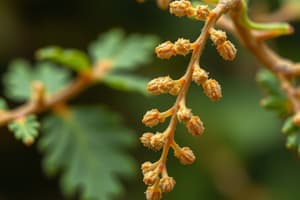Podcast
Questions and Answers
Which factor does NOT directly affect paper formation?
Which factor does NOT directly affect paper formation?
- Humidity of the environment (correct)
- Quality of the wood pulp
- Ingredients used in the paper
- Speed of the moving wire
What is the primary purpose of opacity in paper?
What is the primary purpose of opacity in paper?
- To improve paper strength
- To enhance color vibrancy
- To increase paper thickness
- To prevent images on the backside from showing through (correct)
What does a higher value of paper brightness indicate?
What does a higher value of paper brightness indicate?
- Darker paper shade
- Enhanced color reproduction quality
- More light absorption by the paper
- Increased light reflection at a specific wavelength (correct)
Which measurement assesses the reflective properties of paper across the visible spectrum?
Which measurement assesses the reflective properties of paper across the visible spectrum?
Enhanced smoothness of paper can lead to which of the following benefits?
Enhanced smoothness of paper can lead to which of the following benefits?
What is the primary purpose of wet-strength additives in paper production?
What is the primary purpose of wet-strength additives in paper production?
Which measurement unit is typically used for paper grammage?
Which measurement unit is typically used for paper grammage?
What does the term 'caliper' refer to in the context of paper?
What does the term 'caliper' refer to in the context of paper?
In comparing ISO paper sizes, what aspect ratio is commonly maintained?
In comparing ISO paper sizes, what aspect ratio is commonly maintained?
What does tensile strength measure in paper?
What does tensile strength measure in paper?
Which of the following tests is used to measure tensile strength in paper?
Which of the following tests is used to measure tensile strength in paper?
What is the standard basis weight for a ream of paper in North American measurement?
What is the standard basis weight for a ream of paper in North American measurement?
How is paper bulk defined?
How is paper bulk defined?
Which direction indicates the grain long or grain short of paper?
Which direction indicates the grain long or grain short of paper?
What is the expected tearing pattern observed in paper when the tear is parallel to the grain?
What is the expected tearing pattern observed in paper when the tear is parallel to the grain?
What are wet-strength additives used for in paper production?
What are wet-strength additives used for in paper production?
What is the minimum grammage for a material to be classified as paperboard according to ISO standards?
What is the minimum grammage for a material to be classified as paperboard according to ISO standards?
How does the caliper measurement relate to paper?
How does the caliper measurement relate to paper?
Which ISO standard is primarily concerned with paper sizes?
Which ISO standard is primarily concerned with paper sizes?
What does paper tensile strength measure?
What does paper tensile strength measure?
Which wet-strength additive is specifically used in coffee filter paper?
Which wet-strength additive is specifically used in coffee filter paper?
In paper manufacturing, what is the purpose of adding fillers?
In paper manufacturing, what is the purpose of adding fillers?
Which statement best describes the function of sizing agents in paper?
Which statement best describes the function of sizing agents in paper?
Flashcards
ISO Paper Sizes
ISO Paper Sizes
Standard paper sizes (like A4) used internationally for commercial printing.
Caliper (Paper)
Caliper (Paper)
Paper thickness, measured in microns or points.
Basis Weight
Basis Weight
Weight of 500 sheets of a specific size.
Grammage
Grammage
Signup and view all the flashcards
Paper Bulk
Paper Bulk
Signup and view all the flashcards
Machine Direction (MD)
Machine Direction (MD)
Signup and view all the flashcards
Cross Machine Direction (CD)
Cross Machine Direction (CD)
Signup and view all the flashcards
Paper Stiffness
Paper Stiffness
Signup and view all the flashcards
Tensile Strength
Tensile Strength
Signup and view all the flashcards
Paper Formation
Paper Formation
Signup and view all the flashcards
What affects paper formation?
What affects paper formation?
Signup and view all the flashcards
Opacity
Opacity
Signup and view all the flashcards
How to increase opacity?
How to increase opacity?
Signup and view all the flashcards
Paper Brightness
Paper Brightness
Signup and view all the flashcards
Softwood Pulp
Softwood Pulp
Signup and view all the flashcards
Mechanical Pulp
Mechanical Pulp
Signup and view all the flashcards
Chemical Pulp
Chemical Pulp
Signup and view all the flashcards
Kraft Pulp
Kraft Pulp
Signup and view all the flashcards
Recycled Pulp
Recycled Pulp
Signup and view all the flashcards
Bleaching
Bleaching
Signup and view all the flashcards
Fillers
Fillers
Signup and view all the flashcards
Sizing Agents
Sizing Agents
Signup and view all the flashcards
Study Notes
Paper Production
- Paper is a thin material made by pressing together cellulose fibers from wood, rags, grasses, and drying them.
- The biggest market share in packaging is 50%.
- The first documented papermaking process was in China in AD 105.
- Paper is derived from papyrus, the ancient Greek name for Cyperus papyrus plants.
- Paper is composed of pulp (mechanical, chemical, or recovered), additives (bleaching, fillers, sizing agents), and colourants (dyes, inks).
Pulp
- Pulp is a lignocellulosic fibrous material.
- It's prepared by chemically or mechanically separating cellulose fibers from wood, fiber crops, waste paper, or rags.
- Wood pulp contains cellulose (40-50%), lignin (15-30%), and hemicellulose (15-25%).
- Cellulose is the desired component for papermaking.
- Lignin, the substance that makes wood tough, is removed to improve paper properties.
Wood Pulp Types
- Softwood pulp (35%) is derived from coniferous trees (e.g., pine, spruce) and is long and thin, generally more preferable.
- Hardwood pulp (65%) is derived from broadleaf trees (e.g., birch, maple) and is short and thick, often more economical.
- Lignin content is less in hardwood pulp than softwood.
Paper Properties
- Softwood pulp produces paper that is flexible, strong, and good for printing.
- Hardwood pulp produces paper that is absorbent, opaque, and thick.
Softwood vs Hardwood Pulp
- Softwood pulp is more expensive but offers better flexibility, strength, and printability.
- Hardwood pulp is less expensive but offers better absorbency and opaqueness.
Papermaking Processes
- Mechanical pulping processes don't remove lignin, resulting in a yellowing and brittleness of the paper over time.
- Chemical pulping processes separate lignin from cellulose, preserving fiber length, and avoiding lignin-related deterioration.
- Types of chemical pulp include Kraft, Sulfite, and Soda pulps.
- Recycled pulp can be used to create new paper products. The process of removing inks and impurities is called de-inking.
Paper Additives
- Fillers (e.g., clay, chalk) increase paper mass and strength.
- Sizing agents improve the paper's resistance to water absorption.
Paper Characteristics
- Internal sizing is applied directly to pulp during papermaking.
- External sizing (also known as surface or tub sizing) is added after paper is formed, pressed, and dried; it results in improved wet strength.
- Wet strength is added to prevent the paper from getting weak when it's getting wet.
- Colourants (e.g., dyes, inks) provide colour.
Paper Properties - Measurements
- Grammage: Paper weight per square meter (gsm).
- Caliper: Paper thickness (micron or points).
- Bulk: Ratio of caliper to weight.
- ISO 216: Standard for paper sizes (e.g., A4, A3).
- ANSI: North American paper sizes (e.g., letter, legal).
Paper Properties - Testing
- Tensile strength tests the resistance of paper to tearing.
- Stiffness shows the ability of paper to resist bending.
- Paper's ability to hold up to moisture or curling is essential to avoid problems in paper production.
- Opacity measures the degree of light transmission through paper.
- Brightness and whiteness are measured at a specific wavelength.
Paper Coating and Finishes
- Coated paper has a smooth surface created at the paper mill.
- Coating finishes (e.g., matte, silk, glossy) affect print quality and appearance.
Printing Inks
- Inks are typically liquid or paste solutions; they hold pigments (colorants), and provide workability and drying properties.
Studying That Suits You
Use AI to generate personalized quizzes and flashcards to suit your learning preferences.




